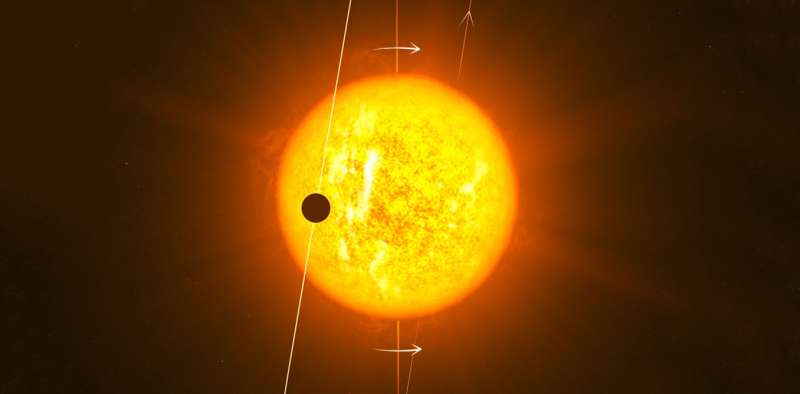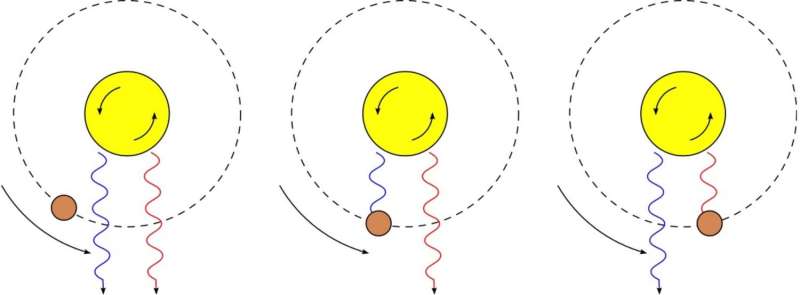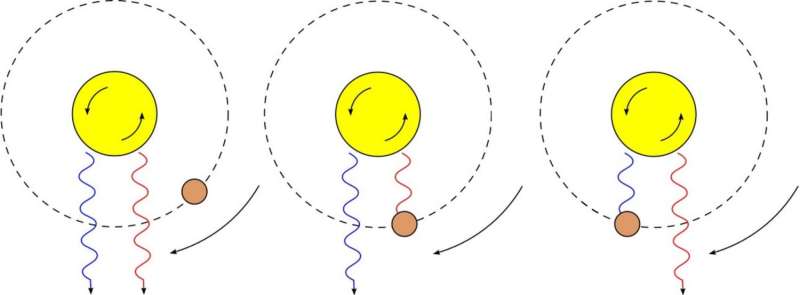An artist’s impression of the polar orbit of WASP-79b. Credit: ESO/B Addison, CC BY-NC
The first of a two part series that looks at what astronomers can find out about the planets that are discovered orbiting other stars in our galaxy.
With the discovery so far of more than 3,300 planets orbiting other stars, the challenge now is to learn more about these distant worlds.
The mere act of discovering an exoplanet gives some information about its nature.
With the two main planet detection techniques – the radial velocity and transit methods – we see a star wobbling or winking, periodically.
The period of the wobble, or the time between winks, tells us the orbital period. From the orbital period, we calculate the size of the planet's orbit. The closer a planet is to its star, the shorter its orbital period.
For planets discovered using the radial velocity technique we can learn a little more about the planet's orbit by studying the way that the host star wobbles. The more circular the planet's orbit, the more regular will be the wobble.
But our observations have revealed that some planets move on orbits that are far from circular. And, as we've discussed before, such planets are an important piece of our best explanation of the origin of some of the strangest planets found to date.
The planet and star rotate in the same direction, a prograde orbit. Credit: Wikipedia/Autiwa, CC BY
Measuring up
The radial velocity method also allows us to estimate the planet's mass. A more massive planet, moving on the same orbit, would cause a larger wobble. But because we're not actually seeing the planet, we don't know the tilt of its orbit to our line of sight.
As a result, the mass we estimate is the minimum the planet could have, assuming that its orbit is edge-on. And we have no idea of the planet's physical size, just an estimate of its mass.
The transit method, by contrast, allows us to work out the physical size of the planet, by measuring the amount of light it obscures during a transit. The bigger the planet, the more light it obscures, and the larger the wink of its host star. But this gives us no information about a planet's mass.
The ideal situation is planets for which we can observe both transits and radial velocity wobbles. The wobble then tells us the true mass, and the transit tells us the planet's size. Put the two together, and we can work out the planet's density, which is the key to determining if it is a rocky or metallic world, or a gaseous behemoth.
For this reason, follow-up observations of planets found using the transit method are of great interest to astronomers. This is driving the construction of several new dedicated radial velocity facilities including Australia's very own MINERVA-Australis.
The true nature of 'hot Jupiters'
Knowing the density of planets is just the start. Astronomers are now applying innovative new techniques to learn even more about some of the strangest exoplanets known, the "hot Jupiters".
A planet moving against the direction its star spins, a retrograde orbit. Credit: Wikipedia/Autiwa (modified), CC BY
Enormous and bloated, these worlds nearly skim the surfaces of their host stars, orbiting with periods of days, rather than weeks or years. Being both massive and close to their hosts, they induce large, easily detectable radial velocity wobbles and transits.
In many ways, they are the low-hanging fruit of the exoplanet world, and are the ideal population to hone the tools that will one day allow us to study distant Earth-like worlds.
Using the stellar rotation
One of the various factors that make it harder to find planets using the radial velocity method is the fact that stars spin on their axes.
Unless the star is pole-on to the Earth, this means that one part of the star is always rotating towards our planet, while another rotates away. As a result, the light from one side of the star will be slightly blue-shifted, while that from the other side will be slightly red-shifted.
The result is the star's spectral lines (the very feature used to measure its radial velocity) will be broadened, with the light we observe being the sum of that emitted from each part of the star's surface that points our way. The faster the spin, the broader the line.
For transiting planets, however, this behaviour is actually beneficial. It affords astronomers an additional tool, allowing them to measure the degree to which the planet's orbit is aligned (or misaligned) with the equator of its host star.
To do this, astronomers make rapid, repeated observations of the star's radial velocity during a transit.
Imagine a planet orbiting in the same direction as its star spins (a prograde orbit).
First, the planet will block part of the side of the star coming towards the Earth. As a result, we will receive more light from the red-shifted side than the blue-shifted side, and all the star's spectral lines will appear to shift slightly to the red.
As the planet moves further along its orbit, it will block parts of the star approaching us more slowly, and then parts moving away, and so the star's lines will gradually shift back to their normal location, then move to the blue.
Finally, as the transit ends, with the star once more unobscured, the lines will shift back to their starting place.
By contrast, for a planet moving against the direction its star spins (a retrograde orbit), the lines will go to the blue, then red and back again.
The technique can even reveal planets that transit off-centre, particularly if they are also moving on tilted orbits (and therefore only block the red or blue side of the star!).
This effect of the rapid red- and blue-shifting of light during a transit was first observed for eclipsing binary stars, almost a century ago, and is known as the Rossiter-McLaughlin effect. By measuring a star's radial velocity through a transit, the tilt the planet's orbit to the star's equator is made clear.
One of us (Brett) is using this technique with some of the world's largest telescopes, contributing to the growing catalogue of planets found on unusual orbits.
The results are startling. Of 91 hot Jupiters with measured orbital tilts, more than one-third are significantly misaligned, tilted by more than 20 degrees, with nine of those planets found moving on retrograde orbits.
Will the same hold as we move from the Exoplanet Era to the ExoEarth Era, and start to find planets like the Earth around these distant stars? Only time will tell, but these results offer a tantalising glimpse of a universe far more complicated than we ever imagined!
Source: The Conversation
This article was originally published on The Conversation. Read the original article.
![]()


























